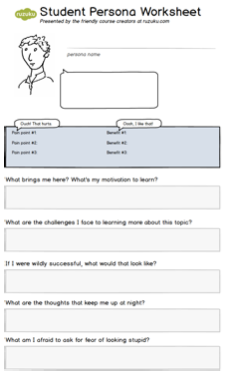Let’s say you’re just getting started with the design and creation of your online course.
If there’s one question you must answer before you go much farther it’s this:
Who is your course for?
Because one of the most common mistakes people make in planning their course is:
Failing to take the time to define their ideal student.
There are two excuses for this.
Excuse #1: The Curse of Knowledge
“Oh, I already know my student!”
And maybe you do have an intuitive understanding of the problems your students face, but by taking the time to write this out, you just might have a few more flashes of insight that can take your course from mediocre to amazing!
Excuse #2: My Course is for Everyone
The second: “Everyone!”
Thinking that your course could appeal to everyone short-changes the people that would really be interested in your course.
And while you might be correct — anyone could be interested in your course, I am certain that not everyone will be interested in your course.
If you identify a type of student and focus on their needs, your marketing messaging and course structure become clearer and more succinct.
David Garland (an entrepreneur and designer of the Create Awesome Online Courses program) says that your course audience and topic should be “laser specific.”
But you’re not just going to answer the question: “Who is my course for?” To really understand your students and their needs, you’re going to create a student persona.
A Practical Solution: The Student Persona
A Student Persona is an archetype of the students who are interested in taking your course.
Think of it as an imaginary student — and you’re going to filter everything through the eyes of your imaginary student.
This imaginary student will have a name and you should call her by this name.
In a lot of ways, she should become a co-creator to your course.
Sounds a bit silly, sure. But when you find yourself asking “Would Robert like it if I did this?” you know that you’re doing it right!
One more note: You should really only have one persona per course.
For many folks, this is difficult, but the more personas you add, the less focused your marketing and curriculum become.
So, if you feel that you absolutely must have a second persona, you are allowed to create ONE secondary persona, but they should be identified as secondary — someone whose needs are not as important as your primary persona. Remember that focus is critical to the creation and successful launch of your course.
Creating the Student Persona
We’ve created a worksheet to help you develop your own student persona.
Print the worksheet and fill in all the details to the best of your knowledge. Don’t fret too much over getting this person exactly right. What you are doing is documenting all the assumptions about your potential students. It doesn’t matter if these assumptions are right or wrong. It only matters that we get these assumptions onto paper so that you know what they are. By naming them, it’s easier to validate (or even invalidate them) and improve your understanding of your student.
Then join our free learning community: 5 Steps to Your Online Course.
Post a PDF or graphic of your persona in the online discussion. We’ll review it and give you suggestions!
There are three parts of the persona: Details, Pain and Benefits, and Q&A.
Details
The Details include the name, a quote, and a summary of who the person is. Save the summary and quote for last, but it’s best to name your persona right away.
Three tips on picking a name:
- Pick quickly. You can spend a lot of time on a name, but really pick one as quickly as you can.
- Be serious about your name choice. Cute names might be fun at first, but they will make it impossible to take the persona — and thus the ideas the persona generates — seriously.
- Match genders as best you can. If expect your class to be a mix of male and female students, it doesn’t matter what gender you select. If your audience is mostly women, make the persona a woman.
The summary is a 3-5 word phrase that describes the person’s personality or needs. Make it short. Make it snappy, if possible, so you can recall it easily. In some ways, the summary becomes a shorthand for the rest of the persona, which is why it’s good to wait until the rest of the persona is complete before summarizing the persona. But if you have a good summary right out of the gate, use it! Just make sure you re-evaluate it every step of the way.
Lastly, there’s the Quote. Here’s where you get to have a little fun. What’s something that your typical student might say about the topic? This is partly to help humanize this character and partly to help summarize her viewpoint on the topic. The quote doesn’t have to be perfect. You might even wait until you’ve talked to a few potential students before adding a quote. (See “Evolving Your Persona” below.)
Pain and Benefit
Next, describe three pain points the person has today — related to your topic, of course! — and how your course will alleviate the pain. You can start with either pain or benefit, but I find it easier to start with the pain — it really puts the benefit in context.
A Pain point doesn’t have to be dramatic — but it has to be significant enough to motivate someone to learn.
A Benefit should be framed as a value statement the student will get from taking your course. It’s best if you look at the Benefit as actually alleviating the pain. In that way, a benefit statement is the inverse of the pain statement.
Q&A
Now we have come to the heart of your persona: The question and answer session. Here, you actually ask your persona a variety of questions about your topic (and a few other things) to better understand who they are. You are, essentially, conducting an interview with this imaginary person.
In the attached worksheet, we have the first five questions you should ask your imaginary student:
- What brings you here? Why are you motivated to learn?
- What are the challenges you face to learning more about this topic?
- If you were wildly successful, what would that look like?
- What are thoughts that keep you up at night?
- What are you afraid to ask for fear of looking stupid?
Write down the answers to these questions.
No, seriously. Write them down.
You’ll want to refer back to the answers in the future AND you’ll give yourself room to embellish and elaborate on the answers. The assumptions you’ve made about your target audience must get out of your head. By naming them, you gain a better understanding of why you are making certain decisions. Further, as you evolve your persona, it becomes easier to let those assumptions go.
Evolving your Persona
Wow. We’re not even finished, yet, and you have already expanded your understanding of your potential student.
To this point, though, you’ve only documented your assumptions. How do you validate (or invalidate) those assumptions?
It’s easy, really: Talk to your potential students and students.
The best method is to pick up a phone and talk to the students. Interview them in much the same way that you interviewed your persona. I suggest recording the conversation (ask permission!) rather than taking notes, so you can listen more closely to what they’re saying. But talking to people who are taking your course or might take your course is critical to fully understanding their needs.
Now, should you stop the process of course creation to do this? That’s only a question that you can answer.
If you are pouring your heart into an 8 week long flagship course, then yeah. Go right now and interview some potential students before you continue.
For a quick mini-course, even if you’re charging for it, I don’t think you need to conduct student interviews before you launch. The idea behind these mini-courses is that you launch them quickly, then get feedback and iterate on the course. And if it’s really not working, you’ve learned a lot about what not to create and can launch another one as quickly as you can!
Need help?
If you’re feeling stuck or would like a fresh set of eyes on your student persona, join our free learning community: 5 Steps to Your Online Course. Post a PDF or graphic of your persona in the discussion. We’ll review it and give you suggestions!




[…] There are many great ways to learn about your audience. […]